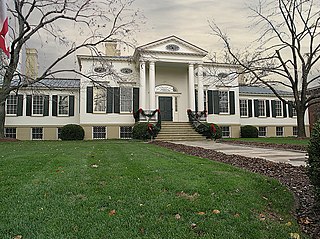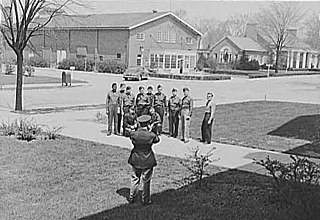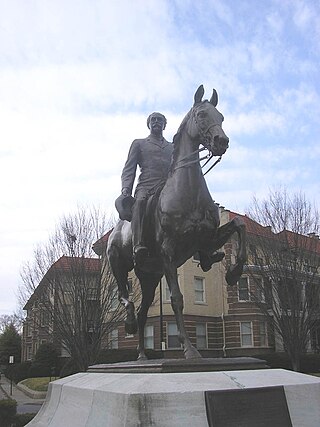
The Drum Barracks, also known as Camp Drum and the Drum Barracks Civil War Museum, is the last remaining original American Civil War era military facility in the Los Angeles area. Located in the Wilmington section of Los Angeles, near the Port of Los Angeles, it has been designated as a California Historic Landmark, a Los Angeles Historic Cultural Monument and has been listed on the National Register of Historic Places. Since 1987, it has been operated as a Civil War museum that is open to the public.

The Freedom Tower is a building in Miami, Florida. It was designed by Schultze and Weaver and is currently used as a contemporary art museum and a central office to different disciplines in the arts associated with Miami Dade College. It is located at 600 Biscayne Boulevard on Miami Dade College's Wolfson Campus.

The Chicago Cultural Center, opened in 1897, is a Chicago Landmark building operated by Chicago's Department of Cultural Affairs and Special Events that houses the city's official reception venue where the Mayor of Chicago has welcomed presidents and royalty, diplomats and community leaders. It is located in the Loop, across Michigan Avenue from Millennium Park. Originally the central library building, it was converted in 1977 to an arts and culture center at the instigation of Commissioner of Cultural Affairs Lois Weisberg. The city's central library is now housed across the Loop in the spacious, postmodern Harold Washington Library Center opened in 1991.

Fort D. A. Russell is the name of an American military installation near Marfa, Texas, that was active from 1911 to 1946. It is named for David Allen Russell, a Civil War general killed at the Battle of Opequon, September 19, 1864.

Minidoka National Historic Site is a National Historic Site in the western United States. It commemorates the more than 13,000 Japanese Americans who were imprisoned at the Minidoka War Relocation Center during the Second World War.

Fort Robinson is a former U.S. Army fort and now a major feature of Fort Robinson State Park, a 22,000-acre (8,900 ha) public recreation and historic preservation area located 2 miles (3.2 km) west of Crawford on U.S. Route 20 in the Pine Ridge region of northwest Nebraska.

The Taft Museum of Art is a fine art collection in Cincinnati, Ohio. It occupies the 200-year-old historic house at 316 Pike Street. The house – the oldest domestic wooden structure in downtown Cincinnati – was built about 1820 and housed several prominent Cincinnatians, including Martin Baum, Nicholas Longworth, David Sinton, Anna Sinton Taft and Charles Phelps Taft. It is on the National Register of Historic Places listings, and is a contributing property to the Lytle Park Historic District.

Camp Douglas was established in October 1862, during the American Civil War, as a small military garrison about three miles east of Salt Lake City, Utah, to protect the overland mail route and telegraph lines along the Central Overland Route. In 1878, the post was renamed Fort Douglas. It was officially closed in 1991 pursuant to BRAC action and most of the property was turned over to the University of Utah. Many of the fort's buildings are preserved and used by the university for a variety of purposes. The Fort Douglas Military Museum is housed in two former barrack buildings, and a small section of the original post is still used by the U.S. Army Reserve. The fort was designated a National Historic Landmark in 1975, for its role in the Civil War and in furthering the settlement of Utah.

Stony Point Battlefield is a historic site in Rockland County, New York; the location of the 1779 Battle of Stony Point during the American Revolutionary War. It is a National Historic Landmark and has a museum.

Fort Benjamin Harrison was a U.S. Army post located in suburban Lawrence Township, Marion County, Indiana, northeast of Indianapolis, between 1906 and 1991. It is named for the 23rd United States president, Benjamin Harrison.

The Lorton Reformatory, also known as the Lorton Correctional Complex, is a former prison complex in Lorton, Virginia, established in 1910 for the District of Columbia, United States.

Midtown is a neighborhood in St. Louis, Missouri. It is located 3 miles (4.8 km) west of the city riverfront at the intersection of Grand and Lindell Boulevards. It is home to the campus of Saint Louis University and the Grand Center Arts District.

Herron–Morton Place is a historic district in Indianapolis, Indiana, United States. The boundaries of the neighborhood are East 16th Street on the south, East 22nd Street on the north, North Pennsylvania Street on the west, and Central Avenue on the east.

The John B. Castleman Monument, within the Cherokee Triangle of Louisville, Kentucky, was unveiled on November 8, 1913. The model, selected from a competition to which numerous sculptors contributed, was designed by R. Hinton Perry of New York. The statue was erected to honor John Breckinridge Castleman at a cost of $15,000 by popular subscription from city, state, and other commonwealths. The statue is made of bronze, and rests on a granite pedestal. It stands 15-feet high, with a base of 12×20 feet. The monument was placed on the National Register of Historic Places on July 17, 1997, as part of the Civil War Monuments of Kentucky MPS. There have been attempts to remove the statue since January 2019 due to the fact that Castleman was a Major of the Confederate army. The monument was removed on June 8, 2020, and is pending cleaning and relocation to Castleman's burial site.
Camp Ruston was one of the largest prisoner-of-war camps in the United States during World War II, with 4,315 prisoners at its peak in October 1943. Camp Ruston served as the "base camp" and had 8 smaller work branch camps associated to it. Camp Ruston included three large, separated compounds for POWs, a full, modern hospital compound, and a compound for the American personnel. One of the POW compounds, located in the far northwestern part of the camp was designated for POW officers. The officer's compound's barracks were constructed to house a lesser number of POWs affording more privacy and room for the officers. The enlisted men's barracks were designed to house a maximum of 50 POWs in two rows of bunks that ran along each side. POW latrines were separate buildings located at the end of each compound.

The Detroit Naval Armory is located at 7600 East Jefferson Avenue in Detroit, Michigan. It is also known as the R. Thornton Brodhead Armory. The armory was designated a Michigan State Historic Site in 1980 and listed on the National Register of Historic Places in 1994.

William Dean Fausett was an American painter. His career spanned over six decades. He painted notable figures like Dwight D. Eisenhower, Ronald Reagan, the Duke and Duchess of Windsor, Grandma Moses, Ezra Taft Benson, and Sir Alexander Fleming. His brother Lynn Fausett was also a painter. Fausett also purchased the historic house of Cephas Kent, Jr. in Dorset, Vermont and was instrumental in it the forming of the Kent Neighborhood Historic District.

Camp Douglas was an internment camp for Prisoners of War (POW) during World War II, located in the city of Douglas, Wyoming, United States. Between January 1943 and February 1946 in the camp housing first Italian and then German prisoners of war in the United States. While there are few remaining structures, the walls of the Officer's Club were painted with murals by three Italian prisoners. These paintings depicting western life and folklore are now registered with the United States Department of the Interior National Park Service on the National Register of Historic Places. The story of this POW camp is an important part of the history of the town of Douglas.

Building 98 at Fort D. A. Russell is the historic US army base bachelor officer quarters, officers club, and grand ballroom near Marfa, Texas; it was active from 1911 to 1946. Building 98 is Located at Fort David A. Russell's central fort complex. It is a project of the International Woman's Foundation and it is the home of the World War II German prisoners of war POW murals.

The Greer Post Office is a building listed on the National Register of Historic Places in Greer, South Carolina. The Colonial Revival-style post office was constructed in 1935 under the supervision of the Public Works Administration during the New Deal era and designed by New York City-based architect Donald G. Anderson, with Louis A. Simon as the supervising architect. Unlike this post office, most New Deal-era buildings were designed by in-house architects.




















